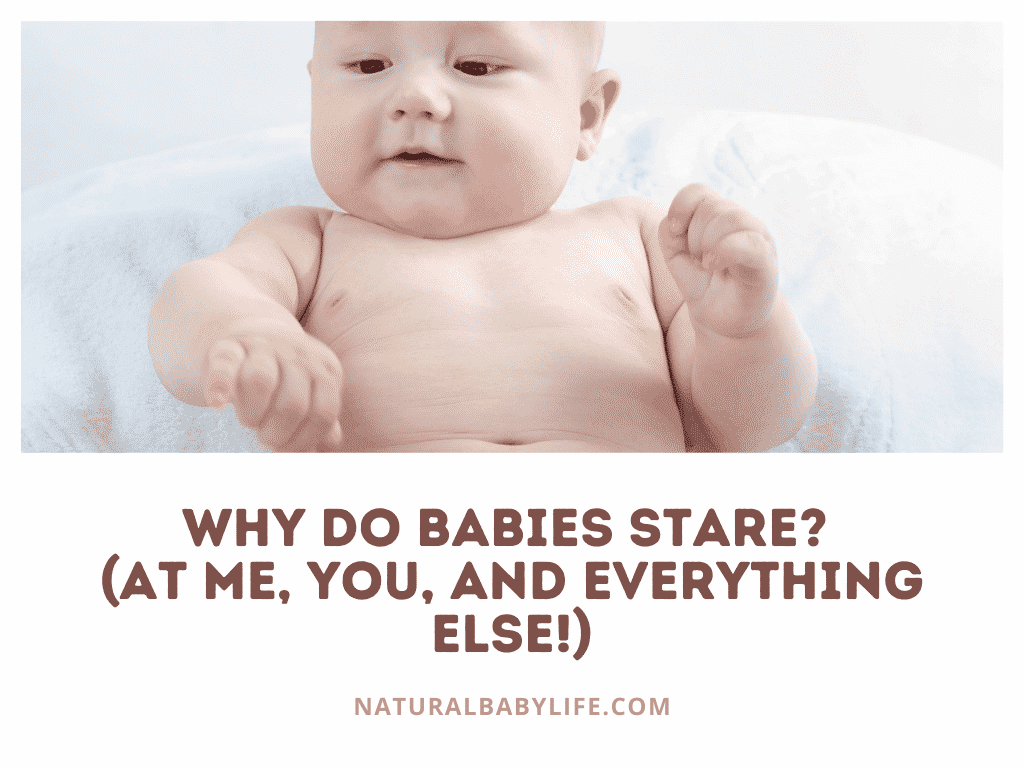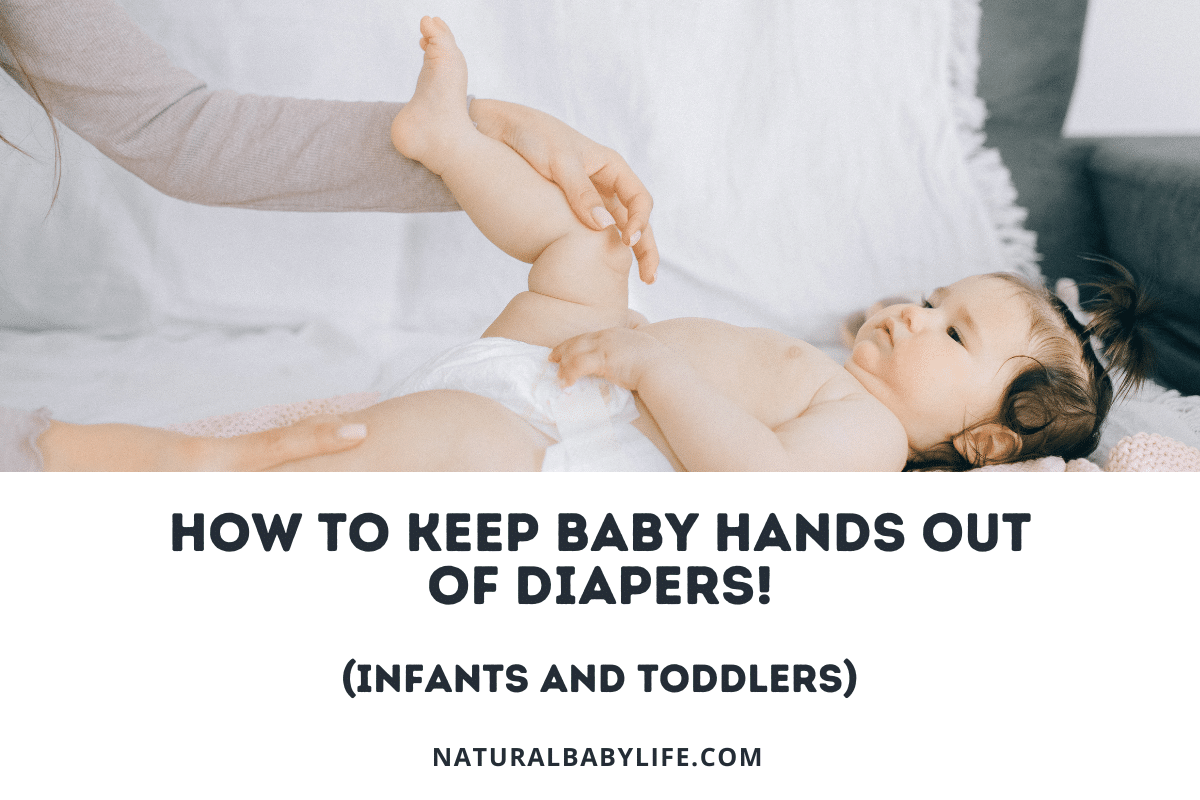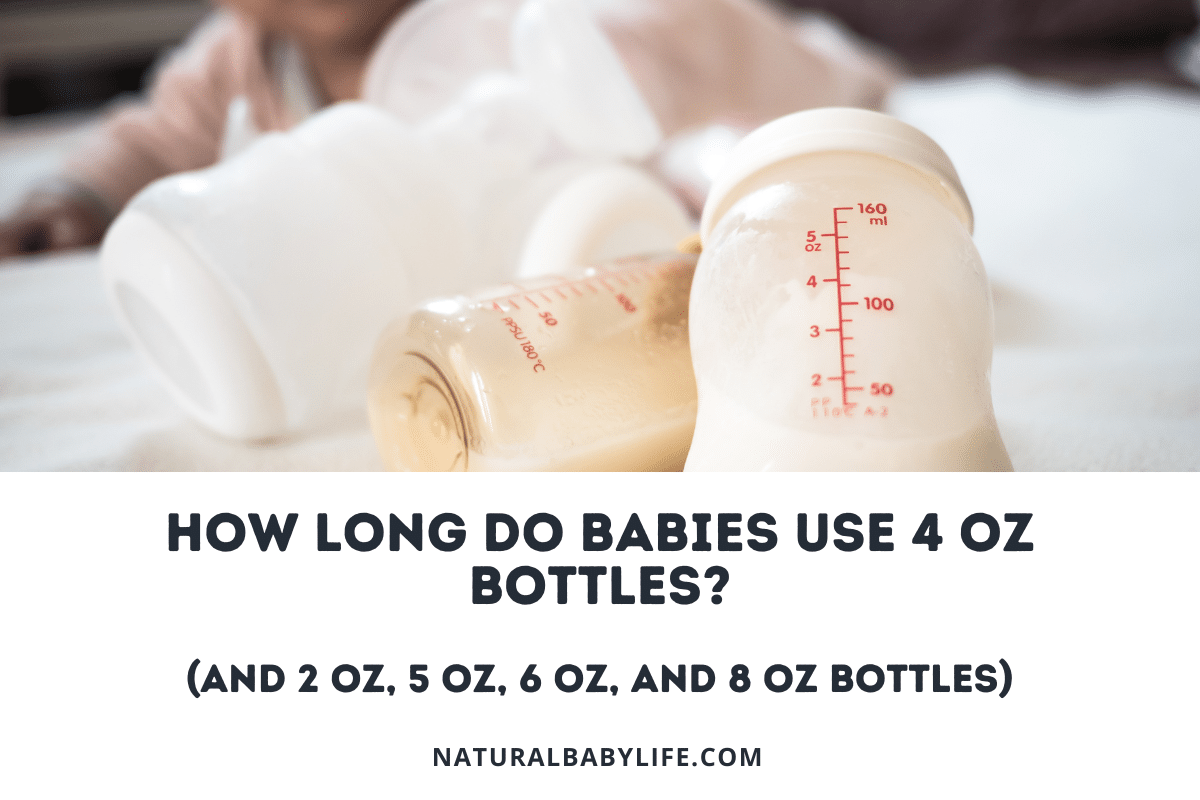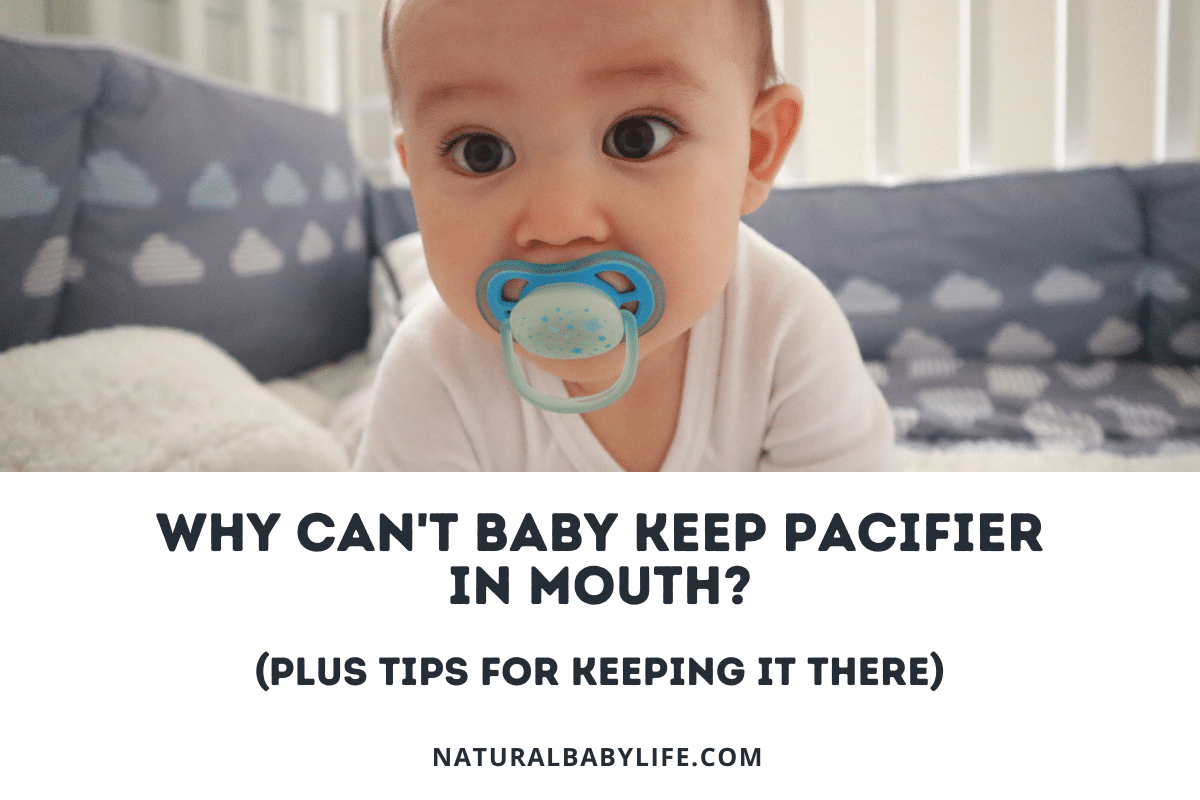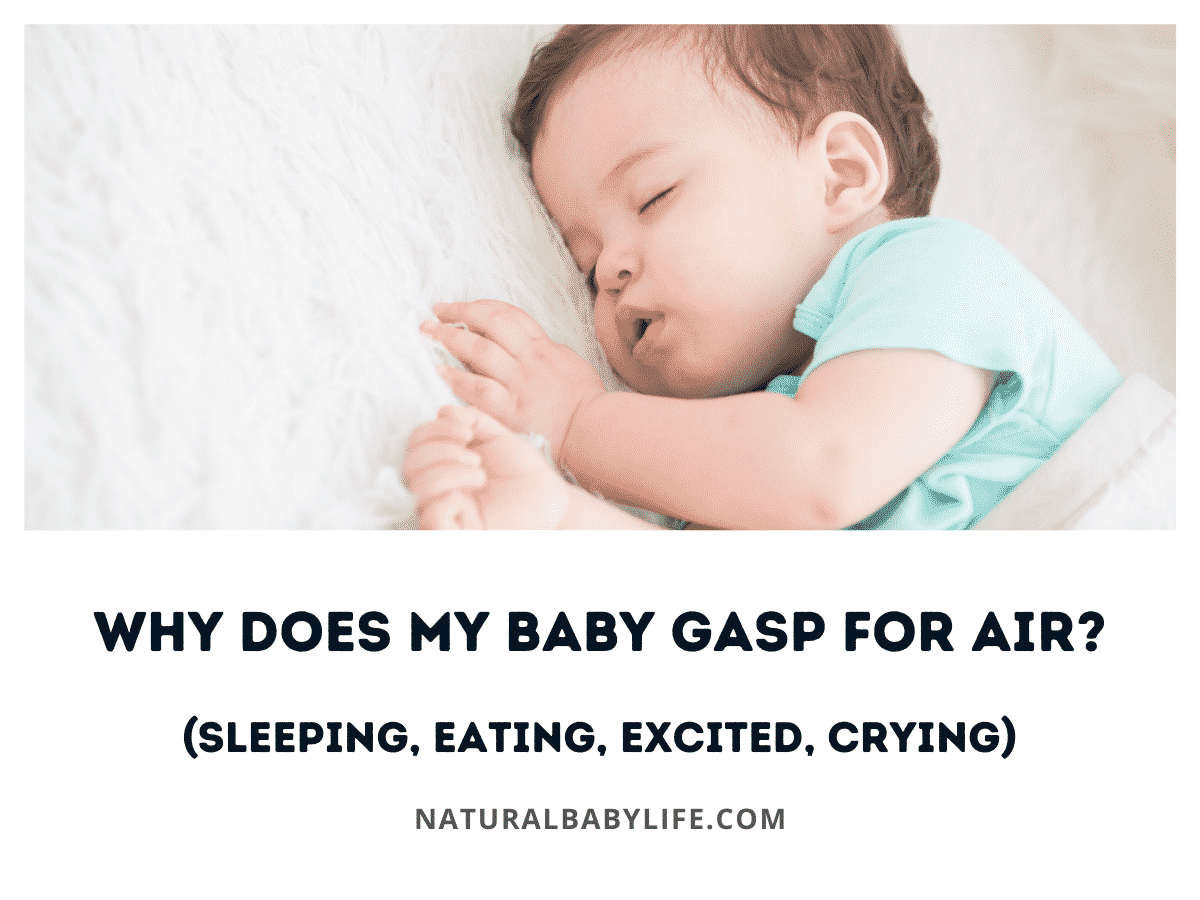Have you ever noticed that babies seem to be absolutely fascinated by what is around them or will fixate on a single thing and ignore everything and everyone else no matter what is going on? My grandfather used to call it “smoking the room over,” while his wife would say, “don’t you just wish you knew what was going on in that head?” As much as we may wish we could understand their minds a little better, the reasons behind a baby’s stare tends to be fairly straightforward and easy to figure out.
Depending on your baby’s age and stage of development, there are a couple of reasons that he might be staring at you, a complete stranger, or the ceiling fan – or why he might be refusing to make eye contact at all – but most of them come down to variations of he is brand new and the world is so big.
Keep reading for insight into why staring is such an important part of your baby’s visual and cognitive development, plus what it means when he’s staring at specific people (mom, dad, total strangers) and things (the ceiling, lights, his own tiny hands).
Table of Contents
Why do babies stare so much?
Have you ever noticed that babies seem to be absolutely fascinated by what is around them or will fixate on a single thing and ignore everything and everyone else no matter what is going on?
My grandfather used to call it “smoking the room over,” while his wife would say, “don’t you just wish you knew what was going on in that head?” As much as we may wish we could understand their minds a little better, the reasons behind a baby’s stare tends to be fairly straightforward and easy to figure out.
When babies are born, they see the world in shades of black, white, and gray. They prefer to look at round, clearly defined shapes, such as faces and even eyes because they are easier to focus on and distinguish from their surroundings. Although it may seem like your baby is fixating on everything in the area, the truth is he can only see the people and items that are very close (8-10 inches) to his face, such as the face of the person who is holding him.
As your newborn grows, different things will start to catch his attention as he becomes able to see them for the first time. In his first couple of weeks, your baby will start to see warm colors such as red, orange, and yellow in addition to the shades of black and gray. This is probably also why red is so many children’s first favorite color – it is the first one that they can actually distinguish from everything else, so they are naturally more drawn to it.
Cooler colors, such as blue, purple, and green come a little bit later. At about one month, your baby will be able to distinguish the primary and secondary colors from the background grays and each other.
As his perception of color develops, your baby will also be able to see items that are farther than a foot away from his face. During his first few months, your baby will gain control of his eyes, and, at around 8 weeks, he will be able to focus on nearby objects, such as the face of whoever is holding him. He will start to make eye contact at around four months.
Then at around five months old, your baby’s eyes will start to work in coordination and his depth perception will develop, allowing him to see clearly in three dimensions for the first time. It is generally considered that around this time, he is able to see in full color (although not in as much detail as adults have) as well.
Why do babies stare at specific people or things?
There are several main reasons that you might catch your baby staring, either into space or at something (or someone) in particular. If your entire perception of the world was constantly changing and everything was always brand new for you, you would stare too!
High contrast and bright colors stand out
Since their eyesight is still developing, small babies have trouble distinguishing between things that look very similar in color or tone because everything blends together in a visual mush. Instead, they are drawn to bright colors and high contrast images because they can clearly separate the colors and patterns.
In their first few months, babies are drawn more to bold shapes and drastically different colors than they are to how “cute” or “pretty” their toys are.
This also helps explain why black, white, and red is such a popular color combination for high-contrast early development toys, and why many older baby toys are colorful to the point of being garish.
Moving objects draw attention
I like to say that every baby’s first best friend is his ceiling fan.
Between the much-loved high-contrast colors of dark fan blades against a white ceiling and the movement of the fan blades, most babies will focus on a ceiling fan to the exclusion of looking at just about anything else.
Although it may seem like your baby has “checked out” when he is staring at a fan, it is actually his way of interacting with the world. (If your baby is actually overwhelmed, he is more likely to look away entirely.)
You are beautiful
Babies are naturally drawn to human features and expressions – mom’s face, dad’s face, close up photographs of people, even his own face in the mirror – but they also show a definite preference for certain faces and features. Immediately from birth, a baby knows what his mother looks like (not to mention what she sounds and smells like), but he will also happily stare at even a total stranger’s face if it meets certain innate criteria.
Although there is some debate as to what makes a person attractive to a baby (conventional attractiveness is inherent, and not a social construct, symmetrical facial structure, facial features that adhere to the golden ratio), it is pretty clear that babies, like adults, prefer to look at things they find visually pleasing.
You are new and interesting
Babies love novelty and an accessory or feature that we think of as completely mundane could be new and exciting to your baby, especially if you are not already a familiar face. Are you wearing a hat? Sunglasses? Maybe your hair is longer than he is used to seeing, or maybe you are taller than his parents.
It may be impossible to figure out what it is about you that makes you stand out, but while a baby is staring at you, take comfort in knowing that you are helping expand his understanding and perception of the world.
They are learning about the world
The biggest reason that babies stare at anyone or anything is that they are taking in information.
Babies are born knowing virtually nothing and unable to see most of their new world. As his eyes develop and he learns more about his immediate daily surroundings, your baby’s interest will expand and he will start taking in more and more each day. It is possible that he will be suddenly incredibly interested in something that has been in the room for his entire life, but he has not given it his full attention yet.
We as adults may have conditioned ourselves to believe that staring is rude or a sign that something is wrong, but it is often a sign of your baby’s intense focus. Staring allows him to observe and process everything that is happening around him a little bit at a time.
Is it normal for babies to stare into space?
Starting almost immediately after birth, your baby’s brain will grow like crazy – 1% every day for their first three months – increasing its size by more than half in just his first three months. That’s a lot of learning!
It’s not surprising that with so much going on, sometimes your baby will get overwhelmed and feel overstimulated. If he just needs a break, or even a nap, he may look away and stare into space. It’s nothing to worry about.
Although you may have heard that staring into space can be a sign of autism, that is typically only true in older children and is unlikely to be indicative of anything serious in an infant. If you are concerned, keep a close eye on your baby and address the issue at your next visit to the pediatrician.
Why do babies stare blankly or without blinking?
Babies tend to stare blankly into the distance when they are either tired or overstimulated and just need to take a mental break. When your baby stares blankly, you in turn may focus on him, and then become concerned if it seems like he is completed zoned out and not blinking.
Here’s the thing: you are probably unconsciously expecting him to blink at the same rate as an adult since that is what you are accustomed to seeing. This could make you think something is wrong, as babies do not blink as frequently as grown-ups. Adults blink about every four seconds (or 15 times a minute), while babies can blink as little as once a minute.
Babies blink less frequently than adults because their eyes are smaller and require less lubrication. Adults also blink in order to refocus their eyes, but babies do not yet have that response because their eyes do not really focus.
If you have heard about petit mal seizures (also known as absence seizures) and are worried, keep in mind that children between 4 and 14 are the ones most likely to be affected. These seizures are also not actively dangerous, even in the very small percentage of babies who are affected. If you are concerned, keep a close eye on your baby and address the issue at your next visit to the pediatrician.
Why do babies stare at me?
Are you one of those people that all babies tend to latch on to and stare at? Chances are there is something about you that makes you stand out, especially to a baby who has not seen much of the world. It could be something as simple as a hat, or glasses, or even the color of your hair. Babies tend to see the same people and faces day after day, so anything about your dress or appearance that differentiates you from their inner circle will draw their attention.
It may even be that your face is pleasantly round or symmetrical and visually appealing to babies. Maybe it is even that you smile a lot since babies are naturally drawn to happy faces, especially if you are also making eye contact.
The fact is that babies love to look at things, especially if they are novel and exciting, and everything is brand new for them.
Why do babies stare at mom?
Chances are good that mom’s face is the one that your baby sees most often. It is a source of great comfort, love, bonding, and stimulation.
After they start making eye contact at around four months, they may also use it as a means of communication and try to express hunger, exhaustion, or need through that connection. There are even studies that show extended eye contact between mother and baby can actually synchronize their brain waves and help the baby develop emotionally.
It may sound obvious, but one of the main reasons a baby will stare up into mom’s face is that he loves her. He is taking in every bit of her face and memorizing it because mom is what love looks like to him.
Why do babies stare while breastfeeding?
If you have ever witnessed a baby breastfeeding, you know that they can stare intensely while nursing, almost to the point of making it awkward. In their first few months, mom’s face is regularly within the limited range of what they can see clearly while nursing, and it is a source of great comfort and love. During this time, everything about the act of breastfeeding helps to forge the bond between mother and baby.
At around four months, a baby’s eyesight has developed enough to focus on his mother’s face, and he will start to make eye contact while nursing. At this point, he is looking for interaction from mom, such as to be sung or talked to. This communication aids in baby’s development, making feeding time much more than just a meal.
Why do babies stare at dad?
Most babies know the sound of their father’s voice before they are even born because they heard it so often through mom’s belly. Once they are able to associate dad’s face with his voice, they will start to seek it out as a familiar source of comfort. Just like babies will stare intensely at mom out of love, they will also focus on and commit their father’s face to memory.
If dad is helping with bottle feeding, the baby could also be seeking out eye contact in the same way he would with mom while breast (or bottle) feeding. Just like the connection between mom and baby, eye contact between dad and baby can synchronize their brain waves and help the baby to develop emotionally.
Why do babies stare up at the ceiling?
Depending on your baby’s age, there are a couple of reasons that he might stare at the ceiling, even when it may seem like there is nothing there.
Newborns are unable to control their head movement and have very low visual acuity (about 8-10 inches) so they are likely to be either staring at something bright like a ceiling light or fan or nothing at all. There may also be a shadow or the profile of an unlit light fixture that stands out because of the contrast between the shape and the light-colored ceiling.
As their eyesight improves, babies will begin to fixate on elements that they could not see previously, especially if they are low in contrast with the background or relatively far away. For example, my son spent a month around the time he was six months old absolutely enthralled by the look of a popcorn ceiling, of all things.
Why do babies stare at lights?
Newborns and young babies do not have very good eyesight, and they have trouble distinguishing between things that look very similar because everything blends together.
Ceiling lights and lamps typically catch babies’ attention, even when they are unlit. These light fixtures are typically designed to stand out either because of their color or finish and tend to create a strong line and a strong, distinct shadow against a light-colored ceiling or wall.
Babies are even more drawn to lights and lamps when they are turned on because the bright lights are one of the few things that will draw a baby’s attention, even shortly after birth.
My first child was born just a couple of days after Christmas and was absolutely mesmerized by the lights on our Christmas trees practically from birth.
If the ceiling light happens to combine babies’ natural love of light with interest in things that move by having a fan as well, your baby will probably stare at it every chance he gets.
Why do babies stare at their hands?
At around two months old, your baby will notice that he has hands for the first time. While his eyesight is developing, things like his hands and feet are all that he will be able to see clearly so they will naturally be incredibly interesting to him. Around this age, he is likely to fixate on his hands and will not look away until he is forced to, either by physically moving them out of his line of sight or distracting him with something else.
Between two and four months, he will gain control of his hands and will spend much of his time learning what he can do with them. After that, he will stop staring at his hands and move on to batting and grabbing with them.
Why do babies stare at strangers?
Babies are often distracted by and stare at strangers, or even try to talk to them once they get a little older. This can initially be awkward and embarrassing when you are out at a restaurant or the grocery store because we are conditioned to believe that staring is rude and that it is only done because something is “weird” or “wrong” with the other person. But babies do not think like that.
Babies stare at strangers because they are interesting and different.
There are many characteristics that might catch your baby’s notice, but it is always out of curiosity and interest. Whether that stranger looks completely different from anyone your baby has ever met, they look similar enough to someone he recognizes to capture your baby’s attention, or they have a specific feature or accessory that is interesting to your baby, he stares because someone has caught his attention and is helping him to expand his understanding of the world around him.

